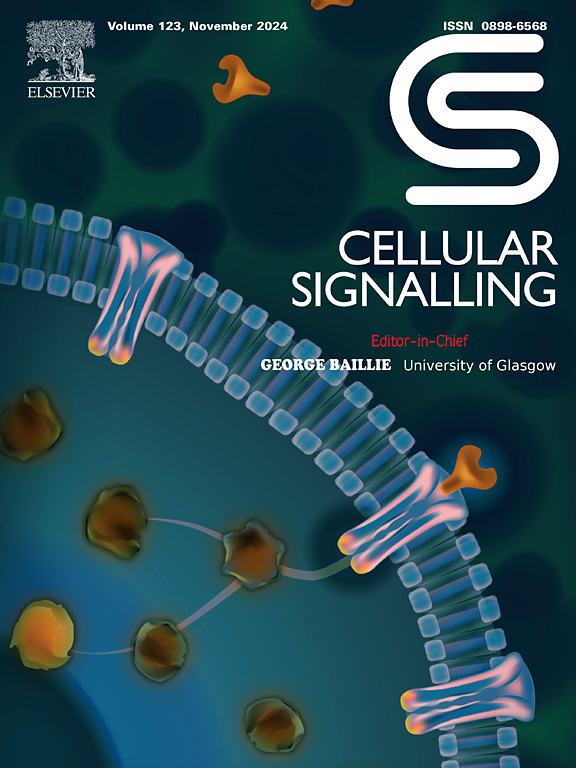JNK相关亮氨酸拉链蛋白通过限制肾小管细胞中的炎症分泌组对肾实质损伤起到保护作用。
IF 4.4
2区 生物学
Q2 CELL BIOLOGY
引用次数: 0
摘要
JNK相关亮氨酸拉链蛋白(JLP)是一种新发现的肾脏内源性抗纤维化因子,它选择性地富集于肾小管上皮细胞(TECs)中。肾小管上皮细胞丢失 JLP 是一个标志性事件,预示着肾脏纤维化的进展。JLP 缺乏会导致一系列有利于纤维化损伤的病理细胞过程。炎症损伤与纤维化肾脏的功能相关,而 TECs 在通过异常分泌助长炎症方面发挥着至关重要的作用。据推测,TECs 中 JLP 的缺失与肾脏纤维化发展过程中的无情炎症有关。本研究利用 Jlp 基因修饰的单侧输尿管梗阻(UUO)小鼠模型或培养的 HK-2 细胞,研究了肾脏纤维化情况下 TECs 中一系列炎症特征的变化。研究发现,TECs 中 JLP 的缺乏会导致炎症细胞因子的分泌显著增加,包括白细胞介素-1β(IL-1β)、肿瘤坏死因子(TNF-α)和单核细胞趋化蛋白-1(MCP-1)、在促纤维化损伤中,核因子(NF)-κB/c-Jun N-末端激酶(JNK)通路过度活化,以及核苷酸结合寡聚化结构域样受体蛋白 3(NLRP3)炎性体介导的脓毒症。此外,JLP的缺失还导致巨噬细胞迁移和成纤维细胞活化的增强,这是损伤的TEC诱发的旁分泌效应。总之,TECs 中 JLP 的缺失催化了肾脏纤维化发展过程中的炎症损伤。本文章由计算机程序翻译,如有差异,请以英文原文为准。
The JNK-associated leucine zipper protein exerts a protective effect on renal parenchymal injury by limiting the inflammatory secretome in tubular cells
JNK-associated leucine zipper protein (JLP) is a newly identified renal endogenous anti-fibrotic factor that is selectively enriched in renal tubular epithelial cells (TECs). The loss of JLP by TECs is a landmark event that heralds the progression of kidney fibrosis. JLP deficiency ensues a series of pathogenetic cellular processes that are conducive to fibrotic injury. Inflammatory injury is functionally relevant in fibrotic kidneys, and TECs play an essential role in fueling inflammation through aberrant secretions. It is speculated that the loss of JLP in TECs is associated with the relentless inflammation during the development of kidney fibrosis. This study examined the alteration of a panel of inflammatory signatures in TECs under kidney fibrotic circumstances using a Jlp gene-modified unilateral ureteral obstruction (UUO) mouse model or cultured HK-2 cells. It was found that a deficiency of JLP in TECs led to a significant increase in the secretion of inflammatory cytokines including interleukin-1β (IL-1β), tumor necrosis factor (TNF-α), and monocyte chemotactic protein-1 (MCP-1), overactivation of the nuclear factor (NF)-κB/c-Jun N-terminal kinase (JNK) pathway, as well as nucleotide-binding oligomerization domain-like receptor protein 3 (NLRP3) inflammasome-mediated pyroptosis in response to pro-fibrotic damage. Additionally, the absence of JLP resulted in enhanced macrophage migration and fibroblast activation as paracrine effects elicited by injured TECs. In conclusion, the loss of JLP in TECs catalyses inflammatory injuries in the development of kidney fibrosis.
求助全文
通过发布文献求助,成功后即可免费获取论文全文。
去求助
来源期刊

Cellular signalling
生物-细胞生物学
CiteScore
8.40
自引率
0.00%
发文量
250
审稿时长
27 days
期刊介绍:
Cellular Signalling publishes original research describing fundamental and clinical findings on the mechanisms, actions and structural components of cellular signalling systems in vitro and in vivo.
Cellular Signalling aims at full length research papers defining signalling systems ranging from microorganisms to cells, tissues and higher organisms.
 求助内容:
求助内容: 应助结果提醒方式:
应助结果提醒方式:


